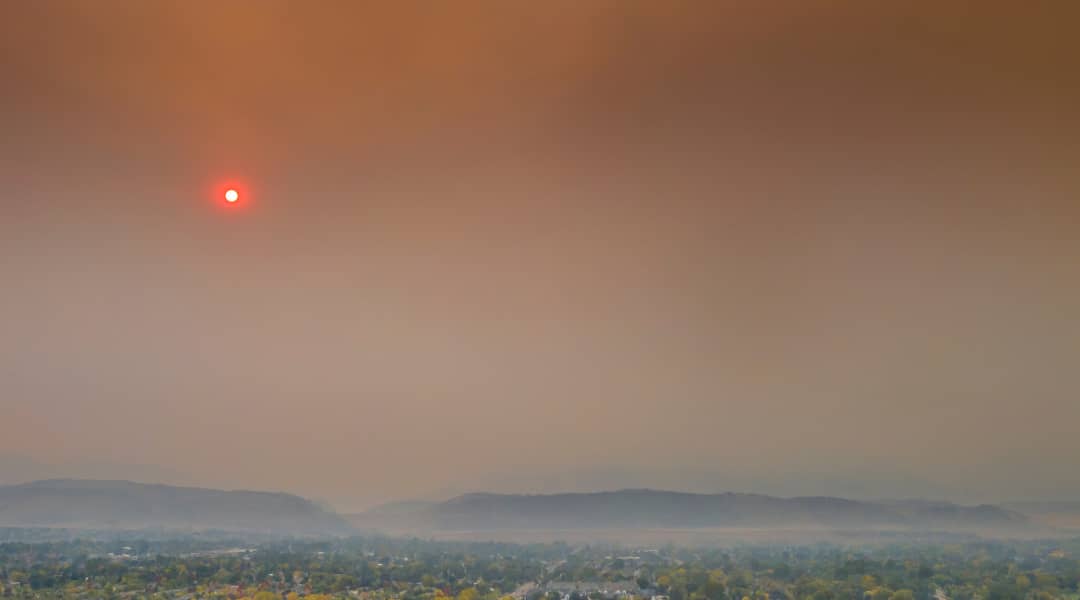WILDFIRES AND HEALTH
The heat this summer has been brutal – as has the physical damage caused by multiple wildfire across California and other States. Largely unnoticed is the toll this is having on our health. The big concern with any wildfire is the air pollution caused by the smoke – particularly the fine particles (PM2.5) that get released into the air. The assumption is that the air quality is always worse where the fire is burning. However, fine particles get picked up by air currents and transported for miles around. This couldn’t have been more obvious than seeing the Fairview Fire, from the hills of Laguna. This photo was taken on September 7th, 2022. See how smoke clouds are moving from inland, out to sea, and in a wide arc? The issue is that anyone can be exposed to the toxins from a wildfire without even realizing it – and this exposure can impact your health. The Fairview Fire, some 100 miles away, is impacting the health of communities for miles around the actual fire itself.

WILDFIRE SMOKE
According to the WHO 99% of people in the world today live in places where air pollution exceeds the WHO guidelines and wildfire smoke adds to air pollution.
Wildfire smoke contains many fine particles along with carbon dioxide and carbon monoxide. Such toxins as Benzene, Styrene, Sulphur Dioxide, Toluene and Aldehydes as well as heavy metals, molds and mycotoxins. It’s a real toxic mix of fine particles. We inhale these particles, as well as absorbing them through our skin. This may initially trigger skin and upper respiratory issues however, as these toxic particles penetrate deeper into the body, they can impact us systemically. Basically, an inflammatory response is triggered that can affect any of our internal organs, (heart, lungs, kidneys, and gut) as well as our immune system. Rather than immediate it may take some time for the impact of this to become apparent.
Human hair is 50-70 microns in diameter. Fine beach sand 90 microns. Dust, pollen and mould is under 10 microns. Combustion particles, organic compounds and metals are under 2.5microns. Research out of the Francis Crick Institute in London has shown that breathing in PM2.5 (fine particles) leads to the release of a chemical alarm – interleukin-1-beta – in the lungs. This causes an inflammatory response and activates cells in the lungs to repair any damage. This sounds like a good response however these studies also showed that about one in every 600,000 cells in the lungs, (for someone who is 50), contains mutations that have been acquired with age. These cells appear completely healthy until they become activated by this chemical alarm. What’s exciting about this is the research actually changes our understanding of how tumors are initiated. Up until this point it was thought that a healthy cell acquires more and more mutations in its DNA until it reaches a tipping point. This new research suggests that cells do go through mutations and remain healthy – until something activates them. The inflammatory response to air pollution, particularly toxic fine particles, could be that activation which is why it’s critical to know the quality of the air you are breathing.
Protecting ourselves from the impact of wildfires is something that should be on our radar. Those with underlying chronic conditions, as well as the very young, and elderly are more at risk, although we are all impacted. In fire season, know if you, your family, and friends are at risk by regularly going to https://aqicn.org/map/california/ and checking the air quality where you live. This is a measure of fine particulate matter 2.5 (known as PM2.5) that I reference above.
If your air quality index is over 150 it’s unhealthy for everyone. Over 101 it’s a risk for the very young, the elderly and those with underlying conditions. If your air quality should become concerning here are my top six health protection tips. I hope you find them helpful.



